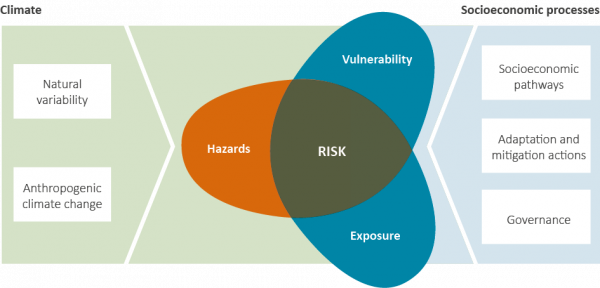Understanding risk
In this report, risk is defined as the interaction of climate-related hazards with the vulnerability and exposure of human and natural systems.

Schematic illustration of the concept of (climate-related) risk as the interaction of climate-related hazards with the vulnerability and exposure of human and natural systems. Changes in both the climate system (left) and socioeconomic processes including adaptation and mitigation (right) are drivers of hazards, exposure, and vulnerability. Source: IPCC (2014)
Risks associated with climate change result from a combination of three factors:
- changes in the frequency and severity of climate-related hazards
- the consequences in terms of exposure of people, infrastructure and ecosystems to those hazards
- their vulnerability to those hazards (i.e. ‘the propensity or predisposition to be adversely affected’) which includes concepts of sensitivity and susceptibility to harm as well as the lack of capacity to cope and adapt.
Understanding New Zealand's sensitivities to climate change
The table below sets out the hazard and vulnerability/exposure for New Zealand's six sensitivities to climate change identified by this report.
Hazard |
Vulnerability/Exposure |
| Living on coasts | |
| Rising sea levels, stronger storms, inundation, coastal erosion | Main population centres on coasts, increasing numbers of people retiring to these areas, coastal heritage sites in these areas. |
| Living on floodplains | |
| Increased extreme rainfall events, floods, inundation, erosion of land | Main population centres on the floodplains of major rivers, urban water supply and storm-water systems not designed for changing climate extreme |
| Surrounded by ocean | |
| Changing ocean temperature, water chemistry and currents. | New Zealand has important fishing, aquaculture, marine recreational use and iconic wildlife. |
| Relying on the availability of freshwater | |
| Increasing frequency and intensity of droughts and risk of wild fire | Urban expansion and increasing demand for water from agriculture, New Zealand’s economy is tied to primary industries strongly linked to freshwater availability. |
| With unique ecosystems | |
| Changing temperatures and moisture availability will change where New Zealand’s species can be located. | New Zealand has many unique indigenous ecosystems, and aquatic managed ecosystems that are critical to the country’s economic, social and cultural well-being, particularly for Māori |
| Relying on strong international connectivity | |
| Climate impacts on international crops, food production and population migration | New Zealand is an open economy with important trading links with Europe, Australia, the US and China. Climate change-related impacts on trading partners have the potential to affect our ability to sell our goods overseas, migration, and social and cultural ties. |
